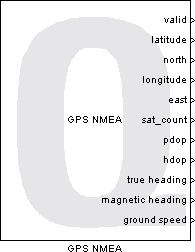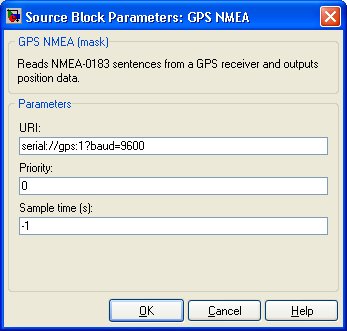

GPS NMEA
Reads NMEA-0183 sentences from a GPS receiver and outputs position data.
| This block is currently a beta version because it does not work with all GPS NMEA devices. If you are using this block, we would appreciate any feedback at tech@quanser.com. |
Library
QUARC Targets Beta/Devices/Third-Party/NMEA/GPS MATLAB Command Line Click to copy the following command line to the clipboard. Then paste it in the MATLAB Command Window: qc_open_library('quarc_library_beta/Devices/Third-Party/NMEA/GPS')
Description

The GPS NMEA block reads NMEA-0183 sentences sent by a GPS receiver over the specified communication channel. GPS position, number of visible satellites, dilution of precision, true/magnetic heading, and ground speed are provided as outputs.
A separate thread is used to read and parse the NMEA sentences sent from the GPS receiver. The most recent GPS data values are then copied when the block executes so that the outputs always represent the most recent data. The data is gathered from the following NMEA-0183 messages: GGA, GLL, GSA, and VTG.
A URI is used to specify the communication protocol and parameters so that data can be received from the GPS.
Input Ports
This block has no input ports.
Output Ports
valid
A Boolean flag that indicates whether the current GPS position data is valid (true) or invalid (false).
latitude
The latitude position of the GPS receiver, given as a double precision value in the format DDMM.MMMM (where D is degrees, M is minutes).
north
A Boolean value indicating whether the latitude position is North (true) or South (false).
longitude
The longitude position of the GPS receiver, given as a double precision value in the format DDDMM.MMMM (where D is degrees, M is minutes).
east
A Boolean value indicating whether the longitude position is East (true) or West (false).
sat_count
An integer indicating the number of satellites used to determine the GPS position.
pdop
The position (3-D) dilution of precision. The PDOP represents a measure of accuracy in the given 3-D position, where a value of 1 is the highest possible confidence level and the confidence level decreases as the PDOP value increases.
hdop
The horizontal dilution of precision. The HDOP represents a measure of accuracy in the given horizontal (latitude/longitude) position, where a value of 1 is the highest possible confidence level and the confidence level decreases as the HDOP value increases.
true heading
The tracked heading based on true North measured in degrees.
magnetic heading
The tracked heading based on magnetic North measured in degrees.
ground speed
The tracked ground speed measured in km/h.
Parameters and Dialog Box

URI
The Universal Resource Identifier (URI) that specifies the communication protocol and parameters used for the GPS receiver. For example, a GPS receiver connected to serial port 1 with a baud rate of 9600 would be specified with the URI 'serial://gps:1?baud=9600'.
Priority
The priority of the thread. In general, a value of 0 indicates the lowest priority and higher values indicate a higher priority. The number of priority levels available depends on the type of QUARC target for which code is being generated.
Sample Time
The sample time of the block. A sample time of 0 indicates that the block will be treated as a continuous time block. A positive sample time indicates that the block is a discrete time block with the given sample time.
A sample time of -1 indicates that the block inherits its sample time from the input. The block inherits the sample time by default.
To set the sample time to the fundamental sampling time of the model, use the qc_get_step_size function, which is a QUARC function that returns the fundamental sampling time of the model. The fundamental sampling time of the model is the sampling time entered in the Fixed step size field of the Solver pane of the Configuration parameters.
Targets
|
Target Name |
Compatible* |
Model Referencing |
Comments |
|---|---|---|---|
|
Yes |
Yes |
||
|
Yes |
Yes |
||
|
Yes |
Yes |
||
|
Yes |
Yes |
||
|
Yes |
Yes |
||
|
Yes |
Yes |
||
|
Yes |
Yes |
||
|
Yes |
Yes |
||
|
Yes |
Yes |
||
|
Yes |
Yes |
||
|
Yes |
Yes |
||
|
Yes |
Yes |
||
|
Yes |
Yes |
||
|
Yes |
Yes |
Last fully supported in QUARC 2018. |
|
|
Rapid Simulation (RSIM) Target |
Yes |
Yes |
|
|
S-Function Target |
No |
N/A |
Old technology. Use model referencing instead. |
|
Normal simulation |
Yes |
Yes |
See Also

Copyright ©2025 Quanser Inc. This page was generated 2025-11-01. Submit feedback to Quanser about this page.
Link to this page.